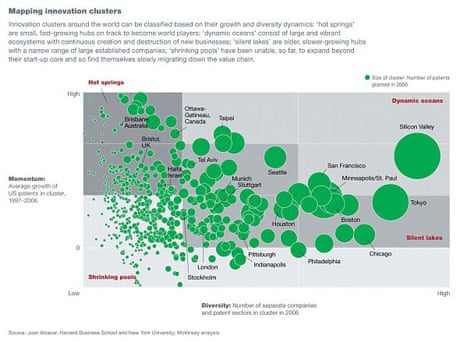Visualisations are only as meaningful as the data that is used to compile them, and this innovation map comes with some weighty credentials.
Compiled by management consultancy McKinsey with the World Economic Forum, researchers used 700 variables including infrastructure, demand, government regulation, human capital and business environment to assess the activity and impact of hundreds of innovation hubs around the world.
The analysis picked out some fascinating trends. Firstly, political stability and the quality of transport and technical infrastructure have to be in place for any innovation hub to succeed. Secondly, hubs tend to develop a specialism and build credibility as an 'innovation hot spring', often around a small number of companies, before expanding.
Those hot springs are typically driven by either targeted, government-led investment projects,
local benefits such as cheap labour and 'knowledge oases' - places with a rich talent pool like an R&D department or research university. Further contributing factors are local regulation, local demand or the local investment scene but staffing remains key.
As well as the local talent pool, hubs need to be able to attract 'world-class talent'. There are emerging problems in Japan and Europe, for example, because of an aging population, and in the US where highly specialised immigrants are starting to return home. For Asia, the challenge is training their growing populations to world-class level.
Survival during a downturn depends on diversification, according to the McKinsey analysis, which has identified three types of mature innovation cluster:
"Dynamic oceans: large and vibrant innovation ecosystems with continuous creation and destruction of new businesses. Leading innovators and primary sectors change organically as the hub frequently reinvents itself through significant breakthrough innovations.
"Silent lakes: slow-growing innovation ecosystems backed by a narrow range of very large established companies that operate in a handful of sectors. These clusters are frequently the source of a steady stream of 'evolutionary' innovations and step-wise improvements.
"Shrinking pools: innovation hubs that are unable to broaden their areas of activity or increase their lists of innovators and so find themselves slowly migrating down the value chain, as their narrow sector becomes less innovation driven and increasingly commoditised."
No surprise that Silicon Valley is a behemoth on this map, but delighted to see Bristol makes an appearance.

Comments (…)
Sign in or create your Guardian account to join the discussion